Some of our favorite moments during the holiday season revolve around Christmas traditions with our family and friends. From holiday cookie and gift exchanges to decorating the tree, hanging up stockings, and gathering around to listen to a beloved Christmas book or watch a favorite holiday film, each of us has little rituals we associate with Christmas and look forward to for the whole year. Some symbols of the season—holiday cards, candy canes, wreaths on doors—are popular in households across the country, but not many of the nine-out-of-ten Americans who celebrate Christmas can tell you exactly where these traditions came from or how they started (for example, do you know the origin of “Merry Christmas”?)
If you’ve ever wondered why Christmas light displays are a thing, where the idea of leaving cookies and milk out for Santa Claus came from, or how boozy eggnog became the official winter holiday drink, read on for our look at the history and legends behind the holiday traditions we know and love today, many of which date back hundreds of years. Be sure to also check out our ideas for the best Christmas movies, favorite holiday songs, and ideas for new Christmas Eve traditions sure to make your season merry and bright.
1、Christmas Cards
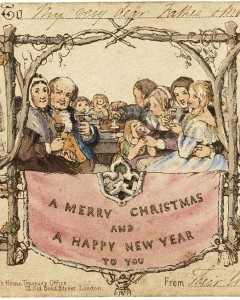
The year was 1843, and Sir Henry Cole, a popular Londoner, was receiving more holiday notes than he could respond to individually due to the advent of the penny stamp, which made letters inexpensive to send. So, Cole asked artist J.C. Horsley to create a festive design he could have printed and mail en masse and—voila!—the first Christmas card was created. German immigrant and lithographer Louis Prang is credited with beginning the commercial Christmas card business in America in 1856, while one of the earliest folded cards paired with an envelope was sold in 1915 by the Hall Brothers (now Hallmark). Today, around 1.6 billion holiday cards are sold in the U.S. each year, according to the Greeting Card Association.
2、Christmas Trees

According to the American Christmas Tree Association, about 95 million households in the U.S. will put up a Christmas tree (or two) this year. The tradition of decorated trees can be traced back to Germany in the 16th century. It’s said that Protestant reformer Martin Luther first thought to add candles to decorate the branches with light after being inspired by the sight of stars twinkling through the evergreens while walking home one winter’s night. Queen Victoria and her German husband Prince Albert popularized the Christmas tree with their own displays in the 1840s and the tradition found its way to the U.S., too. The first Christmas tree lot popped up in 1851 in New York and the first tree appeared in the White House in 1889.
3、Wreaths
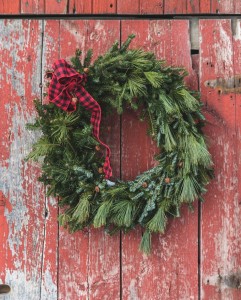
Wreaths have been used by different cultures for various reasons over the centuries: the Greeks handed out wreaths like trophies to athletes and the Romans wore them as crowns. Christmas wreaths were originally believed to be a bi-product of the Christmas tree tradition begun by northern Europeans in the 16th century. As the evergreens were trimmed into triangles (the three points meant to represent the holy trinity), the discarded branches would be shaped into a ring and hung back on the tree as decoration. The circular shape, one without an end, also came to symbolize eternity and the Christian concept of everlasting life.
4、Candy Canes
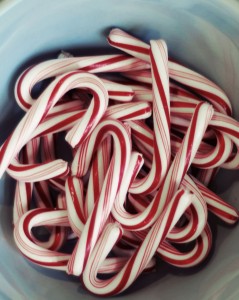
Kids have always loved candy, and legend has it that candy canes got their start in 1670 when a choir master at the Cologne Cathedral in Germany handed out peppermint sticks to keep children quiet during the Living Crèche performance. He asked a local candy maker to shape the sticks into hooks resembling a shepherd’s crook, a reference to Jesus as the “good shepherd” who tends his flock. The first person credited with placing candy canes on a tree was August Imgard, a German-Swedish immigrant in Wooster, Ohio, who decorated a blue spruce tree with sugar canes and paper ornaments in 1847 and displayed it on a revolving platform people traveled for miles to see. Originally only available in white, the candy cane’s classic red stripes were added around 1900 according to the National Confectioners Association, which also says that 58% of people prefer to eat the straight end first, 30% the curved end, and 12% break the cane into pieces.
5、Mistletoe
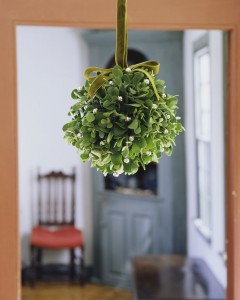
The tradition of kissing beneath mistletoe dates back thousands of years. The plant’s connection with romance began with the Celtic Druids who saw mistletoe as a symbol of fertility. Some think the Ancient Greeks were the first to pucker up beneath it during the festival of Kronia, while others point to a Nordic myth in which the goddess of love, Frigga, was so happy after reviving her son beneath a tree with mistletoe she declared anyone who stood beneath it would receive a kiss. No one’s exactly sure how mistletoe made its way into Christmas celebrations, but by the Victorian Era it was included in “kissing balls,” holiday decorations hung from the ceilings and said to bring good fortune to anyone who had a smooch beneath them.
6、Advent Calendars
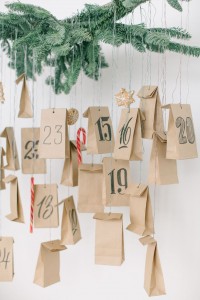
German publisher Gerhard Lang is most often credited as the creator of the printed advent calendar in the early 1900s, inspired by a box of 24 sweets given to him by his mother when he was a boy (little Gerhard was allowed to eat one a day until Christmas). Commercial paper calendars became popular by 1920 and were soon followed by versions with chocolates. Nowadays, there’s an advent calendar for just about everyone (and even dogs!)
7、Stockings
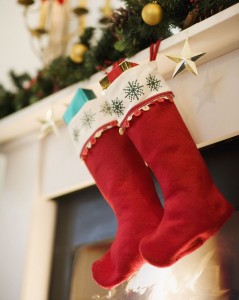
Hanging stockings has been a tradition since the 1800s (Clement Clarke Moore famously referenced them in his 1823 poem A Visit from St. Nicholas with the line “The stockings were hung by the chimney with care”) though no one is quite sure how it started. One popular legend says that there was once a man with three daughters who he worried about finding suitable husbands for as he had no money for their dowries. Hearing about the family, St. Nicholas snuck down the chimney and filled the girls’ stockings, set by the fire to dry, with gold coins.
8、Christmas Cookies

Nowadays Christmas cookies come in all manner of festive flavors and shapes, but their origin stems from Medieval Europe when ingredients like nutmeg, cinnamon, ginger, and dried fruit were beginning to appear in recipes for special biscuits baked during Christmastime. While early Christmas cookie recipes in the U.S. made their debut in the late 18th century, the modern Christmas cookie didn’t emerge until the turn of the 19th century when a change to import laws allowed inexpensive kitchen items like cookie cutters to arrive from Europe according to William Woys Weaver, author of The Christmas Cook: Three Centuries of American Yuletide Sweets. These cutters often depicted ornate, secular shapes, like Christmas trees and stars, and as new recipes to go along with them began to be published, the modern tradition of cooking baking and exchanging was born.
9、Poinsettias
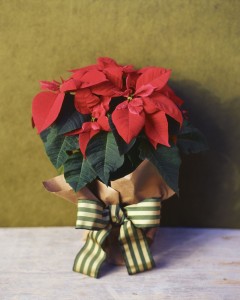
The bright red leaves of the poinsettia plant brighten up any room during the holidays. But how did the association with Christmas start? Many point to a story from Mexican folklore, about a girl who wished to bring an offering to her church on Christmas Eve but who had no money. An angel appeared and told the child to gather weeds from the roadside. She did, and when she presented them they miraculously bloomed into bright-red, star-shaped flowers.
10、Boozy Eggnog
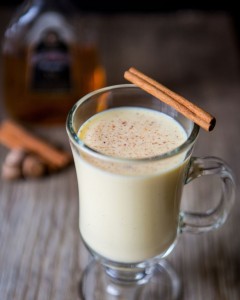
Eggnog has its roots in posset, an old British cocktail of milk curdled with spiced sherry or brandy. For the settlers in America though, the ingredients were expensive and hard to come by, so they created their own cheaper version with homemade rum, which was called “grog.” Bartenders named the creamy drink “egg-and-grog,” which eventually evolved into “eggnog” due to the wooden “noggin” mugs it was served in. The drink was popular from the start—George Washington even had his own recipe.
11、Christmas Lights
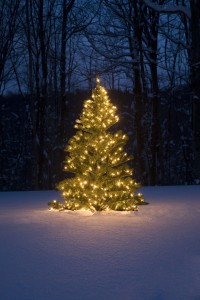
Thomas Edison gets credit for inventing the lightbulb, but it was actually his partner Edward Johnson who came up with the idea of putting lights on the Christmas tree. In 1882 he wired bulbs of different colors together and strung them around his tree, which he displayed in the window of his New York City townhouse (up until then, it was candles that added light to tree branches). GE began offering pre-assembled kits of Christmas lights in 1903 and they became staples in households across the country by the 1920s when lighting company owner Albert Sadacca came up with the idea of selling strands of colored lights in stores.
12、Days of Christmas
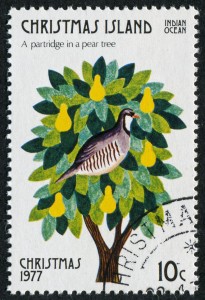
You probably sing this popular carol in the days leading up to Christmas, but the 12 Christian days of Christmas actually take place between the birth of Christ on December 25 and the arrival of the Magi on January 6. As for the song, the first known version appeared in a children’s book called Mirth With-out Mischief in 1780. Many of the lyrics were different (for example, the partridge in the pear tree used to be “a very pretty peacock”). Frederic Austin, a British composer, wrote the version that’s still popular today in 1909 (you can thank him for adding the two-bar motif of “five gold rings!”). Fun fact: the PNC Christmas Price Index has calculated the cost of everything mentioned in the song for the past 36 years (the 2019 price tag was $38,993.59!)
13、Cookies and Milk for Santa
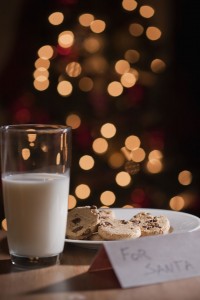 Like many Christmas traditions, this one harkens back to medieval Germany when children left food out to try and coax the Norse god Odin, who traveled around on an eight-legged horse named Sleipner, to leave them presents during the Yule Season. In the U.S., the tradition of milk and cookies for Santa got its start during the Great Depression when, despite hard times, parents wanted to teach their kids to show gratitude and offer thanks for any blessings or gifts they’d receive.
Like many Christmas traditions, this one harkens back to medieval Germany when children left food out to try and coax the Norse god Odin, who traveled around on an eight-legged horse named Sleipner, to leave them presents during the Yule Season. In the U.S., the tradition of milk and cookies for Santa got its start during the Great Depression when, despite hard times, parents wanted to teach their kids to show gratitude and offer thanks for any blessings or gifts they’d receive.
Copy from Internet
Post time: Dec-25-2020




